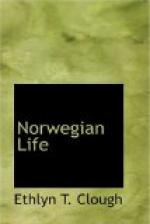There are comparatively few poor in Sweden, probably fewer than in any other European country except Norway and Switzerland, because of the low cost of living, the sparse population, and the ability of all men and women to find work if they are willing to earn their own subsistence. Able-bodied paupers are compelled to work upon poor farms, but the aged, decrepit and invalids who are dependent upon public charity are kindly taken care of by what is called outdoor and indoor relief. In the cities are asylums and almshouses similar to those in the United States, but in the parishes, as a rule, the care of the poor is assigned to individual farmers and others who are willing to take care of them under contract, subject to the supervision of a board of guardians, of which the pastor is the chairman and the elders of the church are members. This has long been a practice in Sweden, but is not universal.
There are at present 5,277 relief establishments of all kinds in the kingdom, and the total contributions for the benefit of the poor amount to $3,000,000 annually, or on an average of 58 cents per capita of the entire population, an average of 44 cents in the country and $1.18 in the cities. This includes all poorhouses, asylums, hospitals, and other institutions for adults and children who can not take care of themselves.
A large part of the relief work in the cities is looked after by the Salvation Army under contract with the municipal authorities, but there are many institutions, hospitals, asylums, homes for the friendless and aged and for orphan children, supported by private charity. The free hospital for children in Stockholm is famous as one of the best equipped and managed institutions in the world.
The private charities in Stockholm are united for cooperation in an organization similar to those found in American cities, and all charitable institutions are subject to government supervision.[l]
CHAPTER XIII
MATERIAL CONDITIONS
The chief occupation of the Scandinavian peninsula is agriculture, employing more men and yielding larger monetary returns than any other industry in either Norway or Sweden. This may seem strange when it is recalled that sixty per cent of the surface of Norway is occupied by bare mountains, twenty-one per cent by woodlands, eight per cent by grazing lands, four per cent by lakes, and two per cent by ice fields, leaving only seven-tenths of one per cent for meadows and cultivated fields. And yet, the products of the farm equal the combined returns from shipping, lumber, and fisheries.
In Sweden the proportion of land under cultivation is considerably larger, the arable lands consisting of about twelve per cent of the total area, and in Sweden as in Norway, the agricultural products are more than those from shipping, lumber, and fisheries combined.




